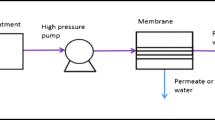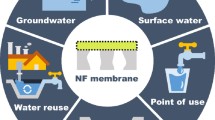Abstract
Membrane distillation (MD) has been increasingly explored for treatment of various hyper saline waters, including lithium chloride (LiCl) solutions used in liquid desiccant air-conditioning (LDAC) systems. In this study, the regeneration of liquid desiccant LiCl solution by a pilot direct contact membrane distillation (DCMD) process is assessed using computer simulation. Unlike previous experimental investigations, the simulation allows to incorporate both temperature and concentration polarisation effects in the analysis of heat and mass transfer through the membrane, thus enabling the systematic assessment of the pilot DCMD regeneration of the LiCl solution. The simulation results demonstrate distinctive profiles of water flux, thermal efficiency, and LiCl concentration along the membrane under cocurrent and counter-current flow modes, and the pilot DCMD process under counter-current flow is superior to that under cocurrent flow regarding the process thermal efficiency and LiCl concentration enrichment. Moreover, for the pilot DCMD regeneration of LiCl solution under the counter-current flow, the feed inlet temperature, LiCl concentration, and especially the membrane leaf length exert profound impacts on the process performance: the process water flux halves from 12 to 6 L/(m2·h) whilst thermal efficiency decreases by 20% from 0.46 to 0.37 when the membrane leaf length increases from 0.5 to 1.5 m.









Similar content being viewed by others
Data availability
The datasets generated and/or analysed during the current study are not publicly available due to regulations of the funding but are available from the corresponding author on reasonable request.
Abbreviations
- C m :
-
Membrane mass transfer coefficient, kg/(m2·h·Pa)
- C p :
-
Specific heat capacity, kJ/(kg·K)
- D :
-
Water diffusion coefficient, (m2/s)
- dm :
-
Water mass flow through an incremental membrane area, kg/h
- dQ :
-
The heat flux through an incremental membrane area, kJ/h
- dx :
-
The length of an incremental membrane area, m
- h d :
-
Mass transfer coefficient of the distillate stream, W/(m2·K)
- h m :
-
Mass transfer coefficient of the membrane, W/(m2·K)
- h f :
-
Mass transfer coefficient of the feed stream, W/(m2·K)
- i :
-
Incremental membrane area index
- J :
-
Water flux, kg/(m2·h)
- k :
-
Water transfer coefficient, m/s
- k g :
-
Gas thermal conductivity, W/(m·K)
- k m :
-
Membrane thermal conductivity, W/(m·K)
- k s :
-
Membrane polymer thermal conductivity, W/(m·K)
- L :
-
Membrane module channel length, m
- M :
-
Molecular weight of water, kg/mol
- m d.in :
-
Distillate inlet mass flow, kg/h
- m f.in :
-
Feed inlet mass flow, kg/h
- P :
-
Total pressure inside membrane pores, Pa
- P a :
-
Partial pressure of air inside membrane pores, Pa
- P m.f :
-
Water vapour pressure at the feed membrane surface, Pa
- P m.d :
-
Water vapour pressure at the distillate membrane surface, Pa
- Q :
-
Heat flux through the membrane, kJ/(m2·h)
- R :
-
Universal gas constant, J/(mol·K)
- r :
-
Membrane pore radius, m
- S b.f :
-
LiCl weight concentration in the bulk feed, %
- Sm .f :
-
LiCl weight concentration at the feed membrane surface, %
- S f.in :
-
LiCl weight concentration at the feed inlet, %
- S f.out :
-
LiCl weight concentration at the feed outlet, %
- T :
-
Mean water vapour temperature inside the membrane pores, K
- T b.d :
-
Temperature in the bulk distillate stream, K
- T b.f :
-
Temperature in the bulk feed stream, K
- T m.d :
-
Temperature at the distillate membrane surface, K
- T m.f :
-
Temperature at the feed membrane surface, K
- δ :
-
Membrane thickness, m
- ε :
-
Membrane porosity
- τ :
-
Membrane pore tortuosity
- μ :
-
Dynamic viscosity, kg/(m·s)
- ρ :
-
Density of the LiCl solution, kg/m3
- ΔH v :
-
Latent heat of evaporation, kJ/kg
References
Abdelkader S, Gross F, Winter D, Went J, Koschikowski J, Geissen SU, Bousselmi L (2019) Application of direct contact membrane distillation for saline dairy effluent treatment: performance and fouling analysis. Environ Sci Pollut Res 26:18979–18992
Alkhudhiri A, Darwish N, Hilal N (2012) Membrane distillation: a comprehensive review. Desalination 287:2–18
Andrés-Mañas JA, Ruiz-Aguirre A, Acién FG, Zaragoza G (2018) Assessment of a pilot system for seawater desalination based on vacuum multi-effect membrane distillation with enhanced heat recovery. Desalination 443:110–121
Andrés-Mañas JA, Roca L, Ruiz-Aguirre A, Acién FG, Gil JD, Zaragoza G (2020) Application of solar energy to seawater desalination in a pilot system based on vacuum multi-effect membrane distillation. Appl Energy 258:114068
Anvari A, Azimi Yancheshme A, Kekre KM, Ronen A (2020) State-of-the-art methods for overcoming temperature polarization in membrane distillation process: a review. J Membr Sci 616:118413
Bindels M, Carvalho J, Gonzalez CB, Brand N, Nelemans B (2020) Techno-economic assessment of seawater reverse osmosis (SWRO) brine treatment with air gap membrane distillation (AGMD). Desalination 489:114532
Chen X, Riffat S, Bai H, Zheng X, Reay D (2020) Recent progress in liquid desiccant dehumidification and air-conditioning: a review. Energ Built Environ 1:106–130
Cheng Q, Zhang X (2013) Review of solar regeneration methods for liquid desiccant air-conditioning system. Energ Buildings 67:426–433
Conde MR (2004) Properties of aqueous solutions of lithium and calcium chlorides: formulations for use in air conditioning equipment design. Int J Therm Sci 43:367–382
Dong G, Kim JF, Kim JH, Drioli E, Lee YM (2017) Open-source predictive simulators for scale-up of direct contact membrane distillation modules for seawater desalination. Desalination 402:72–87
Duong HC, Cooper P, Nelemans B, Cath TY, Nghiem LD (2015) Optimising thermal efficiency of direct contact membrane distillation by brine recycling for small-scale seawater desalination. Desalination 374:1–9
Duong HC, Hai FI, Al-Jubainawi A, Ma Z, He T, Nghiem LD (2017a) Liquid desiccant lithium chloride regeneration by membrane distillation for air conditioning. Sep Purif Technol 177:121–128
Duong HC, Xia L, Ma Z, Cooper P, Ela W, Nghiem LD (2017b) Assessing the performance of solar thermal driven membrane distillation for seawater desalination by computer simulation. J Membr Sci 542:133–142
Duong HC, Álvarez IRC, Nguyen TV, Nghiem LD (2018) Membrane distillation to regenerate different liquid desiccant solutions for air conditioning. Desalination 443:137–142
Duong HC, Ansari AJ, Nghiem LD, Cao HT, Vu TD, Nguyen TP (2019a) Membrane processes for the regeneration of liquid desiccant solution for air conditioning. Curr Pollut Rep 5:308–318
Duong HC, Pham TM, Luong ST, Nguyen KV, Nguyen DT, Ansari AJ, Nghiem LD (2019b) A novel application of membrane distillation to facilitate nickel recovery from electroplating wastewater. Environ Sci Pollut Res 26:23407–23415
Duong HC, Ansari AJ, Cao HT, Nguyen NC, Do KU, Nghiem LD (2020) Membrane distillation regeneration of liquid desiccant solution for air-conditioning: insights into polarisation effects and mass transfer. Environ Technolo Inno 19:100941
Gurubalan A, Maiya MP, Geoghegan PJ (2019) A comprehensive review of liquid desiccant air conditioning system. Appl Energy 254:113673
Hitsov I, Maere T, De Sitter K, Dotremont C, Nopens I (2015) Modelling approaches in membrane distillation: a critical review. Sep Purif Technol 142:48–64
Hitsov I, Eykens L, Schepper WD, Sitter KD, Dotremont C, Nopens I (2017) Full-scale direct contact membrane distillation (DCMD) model including membrane compaction effects. J Membr Sci 524:245–256
Khayet M, Velázquez A, Mengual JI (2004) Modelling mass transport through a porous partition: effect of pore size distribution. J Non-Equil Thermody 29:279–299
Kuang Z, Long R, Liu Z, Liu W (2019) Analysis of temperature and concentration polarizations for performance improvement in direct contact membrane distillation. Int J Heat Mass Transf 145:118724
Lefers R, Bettahalli NMS, Fedoroff N, Nunes SP, Leiknes T (2018) Vacuum membrane distillation of liquid desiccants utilizing hollow fiber membranes. Sep Purif Technol 199:57–63
Liu J, Ren H, Hai FI, Albdoor AK, Ma Z (2021) Direct contact membrane distillation for liquid desiccant regeneration and fresh water production: experimental investigation, response surface modeling and optimization. Appl Therm Eng 184:116293
Lokare OR, Ji P, Wadekar S, Dutt G, Vidic RD (2019) Concentration polarization in membrane distillation: I. development of a laser-based spectrophotometric method for in-situ characterization. J Membr Sci 581:462–471
Lowenstein A (2008) Review of Liquid Desiccant Technology for HVAC Applications. HVAC&R Research 14:819–839
Modi KV, Shukla DL (2018) Regeneration of liquid desiccant for solar air-conditioning and desalination using hybrid solar still. Energy Convers Manag 171:1598–1616
Nguyen NC, Chen S-S, Jain S, Nguyen HT, Ray SS, Ngo HH, Guo W, Lam NT, Duong HC (2018) Exploration of an innovative draw solution for a forward osmosis-membrane distillation desalination process. Environ Sci Pollut Res 25:5203–5211
Salikandi M, Ranjbar B, Shirkhan E, Shanmuga Priya S, Thirunavukkarasu I, Sudhakar K (2021) Recent trends in liquid desiccant materials and cooling systems: application, performance and regeneration characteristics. J Build Eng 33:101579
Yan Z, Yang H, Qu F, Yu H, Liang H, Li G, Ma J (2017) Reverse osmosis brine treatment using direct contact membrane distillation: effects of feed temperature and velocity. Desalination 423:149–156
Zhou J, Zhang X, Su W, Sun B (2019) Performance analysis of vacuum membrane distillation regenerator in liquid desiccant air conditioning system. Int J Refrig 102:112–121
Zhou J, Noor N, Wang F, Zhang X (2020a) Simulation and experiment on direct contact membrane distillation regenerator in the liquid dehumidification air-conditioning system. Build Environ 168:106496
Zhou J, Wang F, Noor N, Zhang X (2020b) An experimental study on liquid regeneration process of a liquid desiccant air conditioning system (LDACs) based on vacuum membrane distillation. Energy 194:116891
Funding
This research is funded by Vietnam National Foundation for Science and Technology Development (NAFOSTED) under the grant number 105.08-2019.08.
Author information
Authors and Affiliations
Contributions
HCD: Conceptualisation, Methodology, Software, Formal Analysis, Resources, Writing-Original Draught;
LDN: Conceptualisation, Methodology, Review & Editing
AJA: Methodology, Validation, Formal Analysis
TDV: Validation, Writing, Review & Editing
KMN: Methodology, Validation, Formal Analysis, Review & Editing.
Corresponding author
Ethics declarations
Ethics approval and consent to participate
Not applicable.
Consent for publication
Not applicable.
Competing interests
The authors declare no competing interests
Additional information
Responsible Editor: Philippe Garrigues
Publisher’s note
Springer Nature remains neutral with regard to jurisdictional claims in published maps and institutional affiliations.
Rights and permissions
About this article
Cite this article
Duong, .C., Nghiem, L.D., Ansari, A.J. et al. Assessment of pilot direct contact membrane distillation regeneration of lithium chloride solution in liquid desiccant air-conditioning systems using computer simulation. Environ Sci Pollut Res 29, 41941–41952 (2022). https://doi.org/10.1007/s11356-021-15783-5
Received:
Accepted:
Published:
Issue Date:
DOI: https://doi.org/10.1007/s11356-021-15783-5




